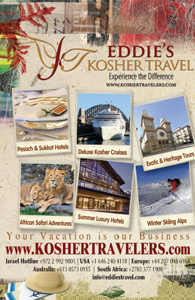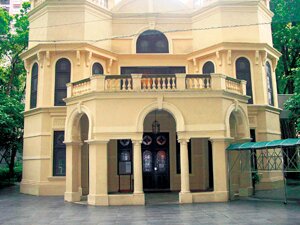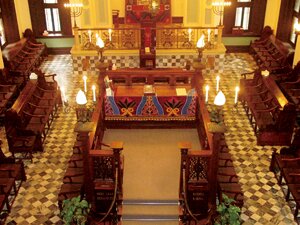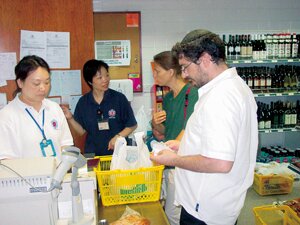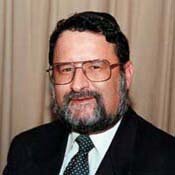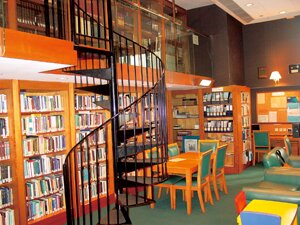| Ohel Leah Hong Kong Community |

|

|
|
Amidst the hustle and bustle of Hong Kong, a thriving business and commercial centre and home to nearly 7 million people, sits the beautiful Ohel Leah Synagogue, a modern orthodox shul. Since its birth in August of 1901, the Ohel Leah Synagogue has been a central part of Hong Kong's Jewish community.Â
Today the synagogue is the spiritual home to nearly 240 families, representing some 20 nationalities. It has grown with the community to reflect the diversification of Jewish life in Hong Kong. The Jewish community of Hong Kong dates back to the 1840s when mercantile interests brought the Kadoorie family to this well situated island trading port. In 1842, Hong Kong became a British Crown Colony following the Opium Wars between China and the British Empire. While Jewish business interests had a long history of ties to Hong Kong this acquisition by the Crown further strengthened ties.  The early permanent Jewish community was comprised of approximately 70 residents in the 1880s and just over 100 by 1920. This community was largely Sephardic as it grew with the success of the business ventures of the Sassoon and Kadoorie families, both wealthy Sephardic dynasties with many strong commercial ties to South East Asia.
The Ohel Leah synagogue was built by Sir Jacob Sassoon in commemoration of his mother Leah, the matriarch of the Sassoon family. Abraham Jacob Raymond, senior member of E.D Sassoon & Co., laid the foundation stone of the new Sassoon-sponsored synagogue on Robinson Road.  A large gathering marked the foundation ceremony as Jacob Sassoon presented this gift to Hong Kong’s Jewish community. The building itself was a gift from Jacob Sassoon and the site a gift from himself & his brothers Messrs Edward & Meyer Sassoon. The building itself built in Colonial style, reflects baroque architectural designs, and is one of the few synagogues, constructed in the nineteenth and early twentieth centuries in Asia, still being used for its original purpose.  This impressive white plastered structure and brick exterior is probably most recognizable by its western façade flanked by impressive towers. Inside, centrally located, a wooden, elevated Bimah is surrounded by candle-like lights. Women are seated separately, upstairs, along three sides of the hall. Also in the early 1900s, the Kadoorie family sponsored the erection of the Jewish club. This club was looted and destroyed during the Japanese occupation in World War II. The Synagogue however survived intact, but Jewish life in Hong Kong came to a halt until after the war. Â
This synagogue was actually the third to be patronized by Hong Kong’s Jewish community & the second synagogue to be named Ohel Leah. In 1870 the site was Hollywood Road, later to be moved to Staunton Street prior to its final move to Robinson Road. Despite the fact that this pinnacle of Jewish life in Hong Kong has celebrated its 100th birthday, the first officially appointed rabbi did not arrive until the 1960s. Services were previously conducted by members of the community itself. The congregation is currently led by Rabbi Edward Jackson. Rabbi Jackson was recommended on a temporary basis by the Chief Rabbi of the UK. Although Rabbi Jackson was serving only on a temporary basis, he and his wife immediately became a welcomed and central part of this community. Â
In October, Rabbi Martin van den Bergh will take over this position. Rabbi van den Bergh is a native of Holland who was raised in Zimbabwe and educated in London. Along with his wife, Rebbetzin Anna van den Bergh, the couple is an ideal fit for this diverse community. Rabbi van den Bergh plans to take on this role immediately following Yom Kippur and the congregation eagerly awaits his arrival. Ohel Leah is also fortunate enough to have programme directors Baruch and Shirli Lobel Lavi to direct the youth programming. In addition to weekly children’s Shabbat programming, the couple runs special holiday programs throughout the year, a summer and holiday camp, and a homework club for members’ children. There are activities available for all age groups. In 1996, the synagogue underwent an extensive two-year renovation to restore the building to its original grandeur. A conservation team assessed the conditions and developed a plan that would make improvements but carefully preserve the building’s heritage. Inappropriately placed fixtures were removed, acoustics were adjusted and modern air-conditioning and lightening fixtures were installed in an unobtrusive manner as to preserve the original design. A museum- quality air-conditioning unit was installed in the area of the Ark in order to carefully protect its contents from the elements including Hong Kong’s unusually high humidity. The contents of the Ark tell a story as well of the rich history of the Jews of Hong Kong and China. In 1974, Father Hubert Vogt, a German friar living in Hong Kong, accidentially discovered 4 Sifrei Torah in the Cat Street ‘thieves’ market. It is believed that these scrolls had belonged to China’s Kaifeng Jews. The scrolls were then purchased by Sir Lawerence Kadoorie for about HK$5000 and then gifted to the synagogue. They still reside in the synagogues’ Ark and further reflect the rich and long history of the Jews in China. Behind the Ohel Leah Synagogue there is a modern mikveh. There are separate mikvehs for men and women. The men’s mikveh is also used for ritual immersion of vessels. Adjacent to this historic building, complete with modern amenities, sits the Jewish Community Centre. This beautiful, modern facility, built in conjunction with the conservation project, houses an Olympic size swimming pool, a baby pool, a gym, meat and dairy kosher restaurants, a kosher market, a school for ages 16 months through 5 years old, numerous conference rooms, catering facilities, offices, and a library.
The facilities are enjoyed by not only the members of Ohel Leah but by the all the other members of Hong Kong’s Jewish community. The building also houses Chabad’s Gan Izzy Camp in the summer and The United Jewish Congregation’s Shorashim Sunday School during the school year.  This new structure shares a courtyard with the synagogue but is a simple modern structure. The two buildings, both old and new, are connected by a bridge in order to preserve the original feel of the older building. In 1997 the community witnessed the return of Hong Kong to China, as Hong Kong became a Special Administrative Region of China. Given the long history of the Jews in China, the transition did not have an effect on the growth of this community. The community is well respected by local leaders and the synagogue itself has likewise been cited as an example of conservation by the Hong Kong Antiquities and Monuments Board. Additionally, the renovated building was chosen as a winner of UNESCO’s Asia Pacific Heritage Award also for its successful cultural heritage conservation. Other recent awards include recognition from the Hong Kong Institute of Architects. But it is not the physical building itself that has provided this structure, the Ohel Leah Synagogue community for over 100 years has provided Hong Kong’s Jewish residents with a sense of belonging and permanency. The modern congregants represent a vast number of different nationalities, are both Ashkenazi and Sephardim, and represent distinct and diverse religious backgrounds. The customs and melodies incorporated into daily religious life reflect the contributions of this diverse religious and cultural group.  The livelihoods of the congregants cover a range of different activities and include not only mercantile interests but include artists, writers, dancers, musicians, professors, entrepreneurs, and lawyers to name a few.  Each one of these individuals and their families contribute to the warmth and uniqueness of Ohel Leah. Ohel Leah emphasizes the willingness to innovate within halacha’s boundaries, in turn providing these families with a contemporary forum capable of meeting their spiritual needs and aiding in their personal growth. The synagogue, itself, has been photographed for representation on calendars, postcards, and in museum exhibits around the world. For its congregants, it is a great source of pride and a constant reminder of the rich history of the Jews of Hong Kong. For Ohel Leah, for over 100 hundred years, it has been the members that continue to allow it to grow and thrive.  Fact Box Ohel Leah Synagogue  (Issue September 2006)Â
|








